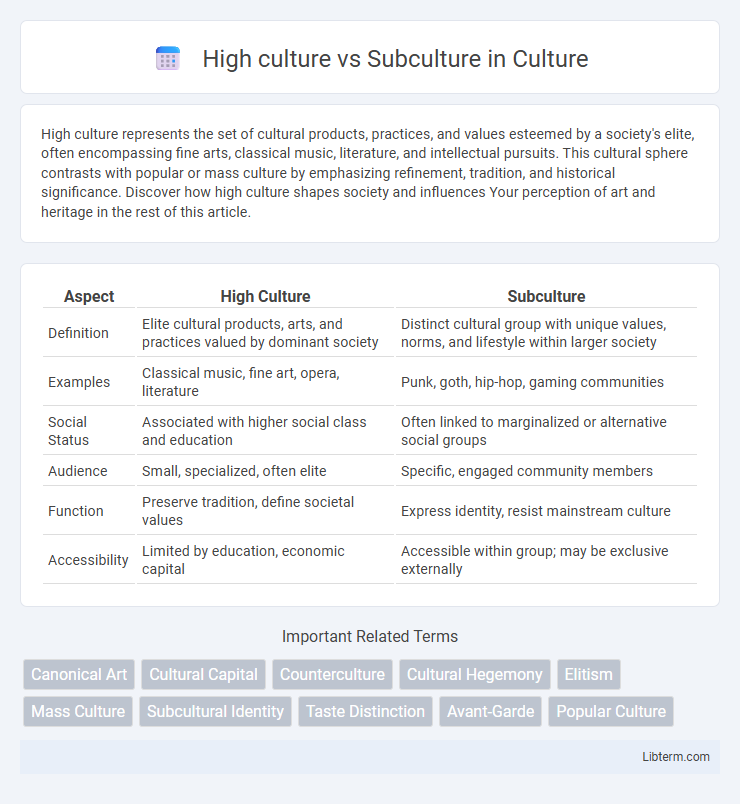High culture represents the set of cultural products, practices, and values esteemed by a society's elite, often encompassing fine arts, classical music, literature, and intellectual pursuits. This cultural sphere contrasts with popular or mass culture by emphasizing refinement, tradition, and historical significance. Discover how high culture shapes society and influences Your perception of art and heritage in the rest of this article.
Table of Comparison
| Aspect | High Culture | Subculture |
|---|---|---|
| Definition | Elite cultural products, arts, and practices valued by dominant society | Distinct cultural group with unique values, norms, and lifestyle within larger society |
| Examples | Classical music, fine art, opera, literature | Punk, goth, hip-hop, gaming communities |
| Social Status | Associated with higher social class and education | Often linked to marginalized or alternative social groups |
| Audience | Small, specialized, often elite | Specific, engaged community members |
| Function | Preserve tradition, define societal values | Express identity, resist mainstream culture |
| Accessibility | Limited by education, economic capital | Accessible within group; may be exclusive externally |
Defining High Culture and Subculture
High culture refers to the set of cultural products, mainly in the arts, held in the highest esteem by a society's elite, including classical music, fine arts, and literature. Subculture consists of distinct groups within a larger culture that differentiate themselves through unique values, norms, styles, and practices, often in opposition to mainstream or high culture. While high culture emphasizes tradition and elevated cultural forms, subcultures focus on identity, innovation, and alternative social meanings.
Historical Origins and Evolution
High culture originated in aristocratic and elite societies, characterized by classical art, literature, and formal institutions dating back to the Renaissance and Enlightenment eras. Subculture emerged in industrialized societies as a response to mainstream cultural norms, often rooted in youth movements, countercultural trends, and marginalized social groups during the 20th century. The evolution of high culture and subculture reflects ongoing social dynamics, with high culture emphasizing tradition and exclusivity, while subcultures promote identity, resistance, and innovation.
Key Characteristics and Values
High culture is characterized by its association with elite art forms, intellectual achievements, and prestige, often emphasizing classical music, fine arts, and literature valued for their historical significance and aesthetic complexity. Subcultures develop distinct norms, styles, and values that differentiate them from mainstream society, often expressing resistance, identity, or alternative beliefs through fashion, language, and music genres such as punk or hip-hop. While high culture prioritizes tradition, refinement, and cultural authority, subcultures emphasize innovation, communal belonging, and challenging dominant social norms.
Influences on Society and Identity
High culture shapes societal norms through established institutions such as classical art, literature, and formal education, reinforcing mainstream identity and social stratification. Subcultures influence identity by fostering alternative values, styles, and practices that challenge dominant cultural narratives and promote diversity within society. Both high culture and subcultures contribute to social cohesion and transformation by negotiating cultural meanings and power dynamics.
Examples in Art, Music, and Literature
High culture in art is represented by classical masterpieces like Leonardo da Vinci's "Mona Lisa," Beethoven's symphonies in music, and Shakespearean literature, reflecting elite traditions and historical significance. Subculture embraces alternative expressions such as graffiti art by Banksy, punk rock music exemplified by the Sex Pistols, and Beat Generation writers like Jack Kerouac, highlighting rebellion and nonconformity. These distinctions illustrate how high culture prioritizes established canonical works, while subculture thrives on innovation and counter-mainstream identities.
Social Perception and Prestige
High culture is socially perceived as elite and prestigious, often associated with classical music, fine arts, and traditional institutions, reflecting wealth and education. Subculture challenges mainstream norms by creating alternative values and practices, sometimes viewed as less prestigious or even marginalized. Social perception varies, with high culture conferring status and authority, while subcultures foster identity and community outside dominant societal frameworks.
Mechanisms of Inclusion and Exclusion
High culture reinforces social hierarchies through exclusive access to elite institutions, education, and cultural capital, effectively excluding those lacking economic or symbolic resources. Subcultures create alternative mechanisms of inclusion by fostering shared values, practices, and spaces that differentiate members from mainstream society while simultaneously excluding outsiders who do not adopt their distinct norms. These processes enable both high culture and subcultures to maintain boundaries that regulate identity, membership, and social cohesion.
Cultural Transmission and Preservation
High culture and subculture differ significantly in their modes of cultural transmission and preservation, with high culture primarily maintained through formal institutions such as museums, academies, and ritualized cultural practices. Subcultures rely heavily on informal, peer-to-peer transmission methods including oral traditions, social media, and community gatherings to preserve distinct identities and shared meanings. Both systems contribute uniquely to the broader cultural landscape by ensuring the continuity and evolution of diverse social values and artistic expressions.
Conflict and Interaction Between Cultures
High culture, characterized by elite art, literature, and traditions, often clashes with subcultures that challenge dominant societal norms through alternative values and practices. The interaction between high culture and subcultures generates dynamic cultural exchanges, fostering innovation and social change as subcultures resist assimilation and maintain distinct identities. Conflicts arise from struggles over cultural legitimacy, power, and representation, highlighting ongoing tensions in societal hierarchies and cultural acceptance.
The Future of High Culture and Subculture
The future of high culture is increasingly shaped by digital innovation and global cultural exchanges, which blend traditional forms with contemporary interpretations, expanding accessibility and relevance. Subcultures continue to thrive through online communities and social media platforms, enabling diverse, decentralized expressions that challenge mainstream norms and foster niche identities. As technology advances, the boundaries between high culture and subculture blur, promoting hybrid cultural landscapes driven by participatory engagement and evolving artistic practices.
High culture Infographic

 libterm.com
libterm.com